Most animal appendages have obvious uses, but the evolutionary dice that dictate all adaptations sometimes land quite oddly. Old parts occasionally gain new and awesome utilities.
大多数动物身体的附属部位都有显而易见的用途,但是慢慢进化的身体部位为了适应生存环境而变异出了奇特的功能,从而使原有的部位获得了新的甚至是更神奇的功能。
10.Horses Use Their Ears And Eyes To Point And Communicate
10.马儿们用它们的耳朵和眼睛来指路和交流
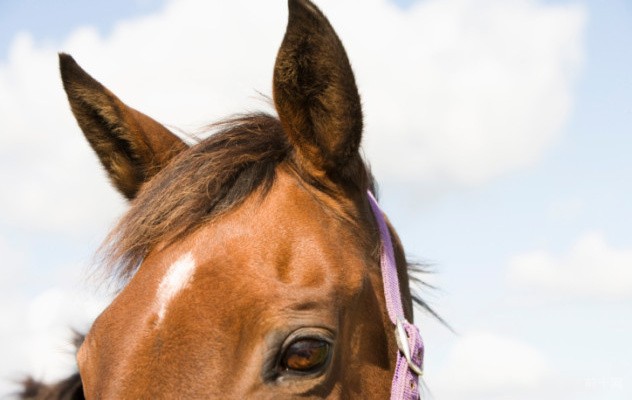
Horses are a lot more articulate than we thought. They communicate not only through snorts, brays, and neighs, but also with eyes and ears, the latter of which are highly pliable and used like equine turn signals.
马儿比我们想象中更加善于表达自己。它们不仅通过擤鼻涕的声音、模仿驴子的声音和嘶叫来沟通,还通过眼睛和耳朵来交流,尤其是它们的耳朵非常柔软灵活。在马儿中,耳朵的用途就如同转向灯在汽车中的用途一样重要。
In a study, University of Sussex PhD student Jennifer Wathan and her adviser Karen McComb photographed horses looking at buckets of food. They then altered some of the images to obscure either the eyes or ears before scaling the photographs to life-sized proportions and showing them to real horses who were given a choice between two similar feed buckets.While looking at the unadulterated images, test horses tended to go for the same bucket as their facsimile compatriots. When the ears or eyes were obscured, this behavior disappeared. Of the two modifications to the images, the test subjects heeded the directions of the ears a bit more than the eyes. The study suggests that our wriggly-eared companions use these gesticulations to either point out food or to alert others to the presence of predatory animals. We probably would have figured this out sooner, but sometimes innate anthropocentric biases limit our scientific vantage point. Studies on animal linguistics often focus on gestures, postures, and calls because these are the main components of our language.
在一个研究中,苏塞克斯大学的博士生詹妮弗和她的指导老师凯伦·麦库姆拍到了马儿们正在盯着几桶食物看的照片。而后他们改变了一部分拍摄照片的内容,照片中的马儿们有的被遮住眼睛来选择不同的食物,有的是被遮住耳朵来选择。随后他们将照片调成和原物一样的比例,再把这些照片给没有遮住眼睛或耳朵的被测试的马儿们看,让它们在不同照片上的两桶食物中进行选择。被测试的马儿们在看没有修改过的照片时,倾向于和照片上的“同胞们”选择其中同一个装有食物的桶。当被测试的马儿看到照片中被遮住眼睛或耳朵的“同胞们”时,这种同照片上“同胞们”选择一致的行为消失了。在两次对原照片的改动当中,被测试的马儿们更注重照片中的“同胞们”对于耳朵在食物选择中所起的作用。研究发现,我们那些会摆耳朵的动物伙伴们,通过摆动它们的耳朵来指出食物所在,或警示凶猛食肉动物的出没。我们也许很快就能发现其中的奥秘,但有时候我们人类固有的“人类中心说”制约了我们在科学探索方面的优势。我们研究动物语言,经常关注它们的手势、姿势和呼叫声,因为这些是我们人类语言沟通的重要组成部分。
9.Hippos Use Their Tails To Propel Feces
9.河马用它们的尾巴来清扫粪便
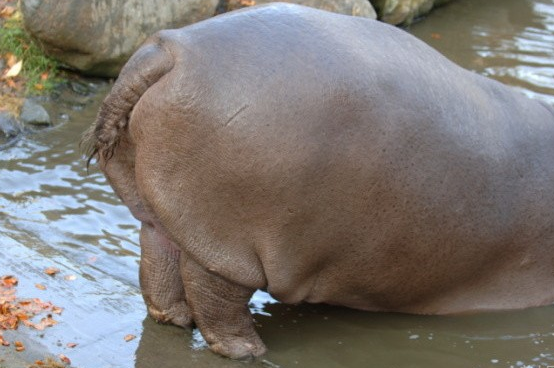
With its dopey face, puffy body, and short, stubby tail, the hippopotamus is one of the animal kingdom's most deceptive killers. Among the most dangerous creatures on Earth, hippos lull victims into a false sense of security with pudgy cuteness and then strike with lightning reflexes and scimitar teeth.
拥有愚钝的面庞,庞大的身躯,短而粗的尾巴,河马是动物王国里最能迷惑人的杀手。在世界上最凶猛的动物世界里,河马用自己笨重而可爱的身材让猎物陷入“安全”的幻境,然后以出其不意的速度和尖利的牙齿来攻击猎物。
But not everything about these animals is terrifying. Their tiny tails are hilarious not only in design but in function as well. You see, dominant male hippos mark their territory by scattering excrement, but they're too fat and lazy to walk around to do so. Instead, they twirl their little tails around like leathery propellers and defecate into the whirling blades.And so they spread their feces—mixed with a touch of urine for extra pungency—haphazardly in all directions to deter rival bulls from encroaching on their land. Oddly enough, juvenile hippos are inexplicably drawn to smelly dumps, and young are known to follow older males around to lick at their rear ends.
但并不是所有的关于河马的描述都这么恐怖。河马小巧的尾巴不仅看着滑稽,用途也很有趣。你看,那些占主导地位的公河马通过分散它们的粪便来划定它们的领地界限,但是它们太懒了又那么胖,不便走来走去清扫粪便。相反,它们快速旋转它们的小尾巴,就像飞速旋转的皮质螺旋桨那样清除粪便。它们还将分散的粪便和尿液混合来制造刺鼻性气味,随意地从各个方向阻止它们的对手——公牛侵犯它们的领地。令人难以理解的是,小河马却对散发着恶臭的粪便异常着迷,也特别喜欢跟在年长公河马后面舔舐它们的屁股。
8.Trap-Jaw Ants Launch Themselves To Safety With Their Mandibles
8.大齿猛蚁可以利用自己的下颌“金蝉脱壳”
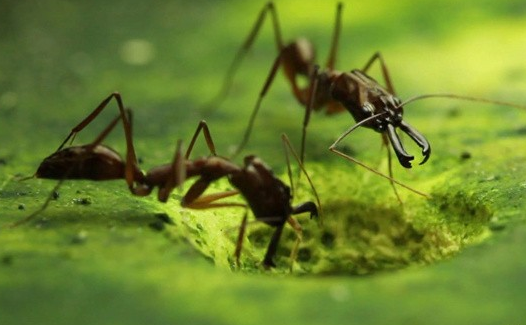
Trap-jaw ants have shears for mandibles and can snap them at 40 meters per second (90 mph). With such speed and size, they can easily cleave enemies in half in the blink of an eye. Amazingly, it turns out they can use their oversized jaws for defense as well as assault.
大齿猛蚁下颌的咬合力极强,其上下颌闭合速度可达40米/秒(90英里/时)。这种咬合速度及力度,眨眼间就能将敌人劈成两段。神奇的是,它们的巨型下颌还是个“进可攻,退可守”的利器。
Researchers had noted that the ants would sometimes flick themselves into the air with their incredibly strong mandibles. It wasn't clear why—possibly as an evasive maneuver.As always, scientists tried to understand this puzzling behavior by reproducing it in the lab. They brought in some antlions, larger insects that love to eat ants. To capture their prey, antlions build pits in the sand that crumble beneath the unlucky ants' feet. Waiting inside the pit, the antlion gobbles up anyone that falls through. Sure enough, trap-jaw ants that were at risk of sinking into the sand sometimes used their mandibles to propel themselves away from danger. Furthermore, the ants that had their jaws glued together were only half as likely to escape their fate as dinner.
研究者们注意到,大齿猛蚁有时会利用它那壮硕无比的下颌把自己弹向高空。目前还没有探明其原因——可能是一种逃生的战略吧。如往常一样,每当科学家们想要了解这些令人困惑的生物行为时,他们就会在实验室里还原出这一行为过程,以便观察研究。他们带回了一些蚁狮——体积更大且喜食蚂蚁的昆虫。为了诱捕猎物,蚁狮会在沙土中设下陷阱,待某只不走运的蚂蚁失足落入陷阱,再把它大卸八块,侵吞入腹。所有自投罗网的昆虫都会被蚁狮吃掉。可以肯定的是,大齿猛蚁有时也会落入沙土陷阱,而它们的下颌则有助于帮其脱离险境。此外,当落入陷阱的大齿猛蚁的下颚被黏住时,它们仅有一半的机会能够避免成为其他生物的“盘中餐”。
7.Sawfish Snouts Detect Electrical Fields
7.锯鳐的吻锯可以探测电场
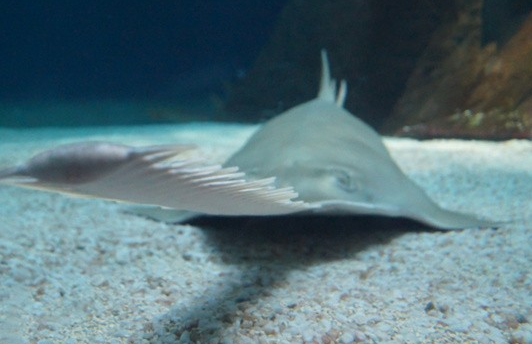
The sawfish is a feared aquatic predator. Its large, serrated appendage makes for an intimidating weapon that can slice smaller fish clean in half. But the sawfish's multi-tool muzzle can also detect electrical fields produced by living creatures.
锯鳐是一种令人生畏的水下“猎食者”。它有一件恐怖的杀伤性“武器”——庞大的锯齿状鱼吻,可以将小一些的鱼切割成两半。它的多功能吻锯还可以检测出活体生物所产生的电场。
While dissecting a few sawfish specimens—that had died naturally—researchers found their fimbriated snouts were full of tiny pores. These were indicative of the animal's electrical prowess, and similar pores are present in other creatures that share this talent. These sensors are usually dotted around the mouth so that the fish can quickly clamp down on anything unlucky enough to trigger its electro-location.It might seem unfair that evolution gave a saw-faced beast what amounts to a video game mini-map, but it's a necessary tool when one lives in exceedingly murky waters where visibility is measured in millimeters if the sediment has been stirred. By using its saw as an electrical walking stick and rangefinder, the sawfish remains lethal where most would be blind.
通过解剖少数自然死亡的锯鳐的样本,研究者们发现它们的吻锯镶边处长满了微小的毛孔。这些代表着它接收到的来自其它动物的电场强度,其它拥有此项天赋的生物身上也会有与之相似的毛孔。这些传感器分布于鱼吻四周,致使锯鳐可以快速地通过电场位置判断猎物的方位,进而给予这不走运的家伙致命一击。上天似乎很不公平地让一个怪兽还进化出了带锯齿状的脸部,这就如同在电视游戏中加入了迷你地图功能。但对于生活在深海——一旦有沉淀物被搅拌起来,可见度只能以毫米计算的浑水中的生物来说,这一“工具”是不可或缺的。有了此等“移动标杆”及“测距仪”,锯鳐才能在大多数物种都看不清的情况下完成致命绝杀。
6.Ants Use Their Antennae To Grip Tunnel Walls
6.蚂蚁用触角来抓着墙壁
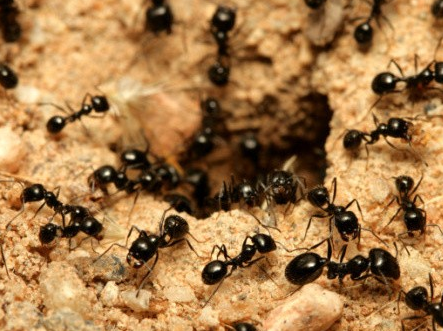
Not long ago, researchers conducted one of the most detailed studies of ant tunneling ever. It's a common practice to fill a clear container or tube with dirt and watch the ants do their thing, but this time, X-ray tomography allowed researchers to watch the ants work under more natural conditions.
不久前,研究者们对蚂蚁的隧道挖掘行为进行了前所未有的详细研究。这项研究通常的做法是,在透明的箱子或管道里装上泥土,然后观察蚂蚁们如何巧夺天工。而这一次,由于采用X光断层扫描,使研究者们能够在更加天然的环境中观察蚂蚁工作了。
They found the tunnels were built to precise, optimal dimensions for structural integrity. To induce a mini-collapse (to observe how the poor ants cope and rebuild), scientists used a small piston to shoot a stream of air into the tunnel. To their amazement, the momentarily displaced ants latched onto the sides of the tunnel with their antennae, displaying an entirely novel use of the common appendage.It turns out that the tunnels are not only built for strength, but small enough to allow the ants to catch themselves against the walls—quite a useful adaptation for busy little insects that spend considerable time traversing a vertical maze of tunnels.
研究者们发现,蚂蚁的隧道在建筑结构的完整性上,不仅精确而且尺寸大小绝佳。为了观察蚂蚁们在隧道坍塌后如何应急和重建,科学家们用一个小活塞把一股气流射进蚂蚁的隧道里,以此引发一个小型坍塌。让他们惊讶的是,那些在瞬间被吹飞的蚂蚁们竟然用自己的触角牢牢抓住隧道的墙壁,使这对作为身体附肢的触角有了一个全新的用途。研究结果显示,蚂蚁建造的隧道不仅仅很坚固,还因为隧道够小而让它们掉落的时侯能从墙壁上稳住自己——对于这些整天在隧道的垂直迷宫里来回穿梭忙碌的小昆虫们而言,能够用触角抓住隧道墙壁确实是一个很有用的适应能力。

















